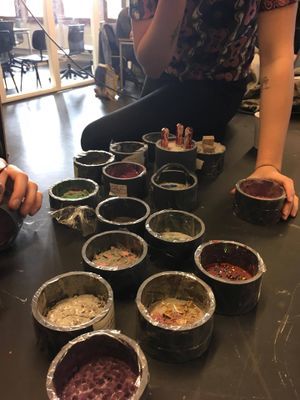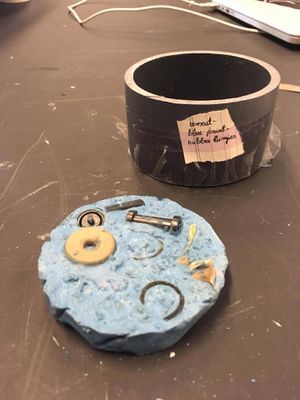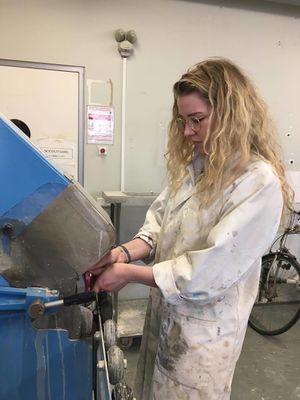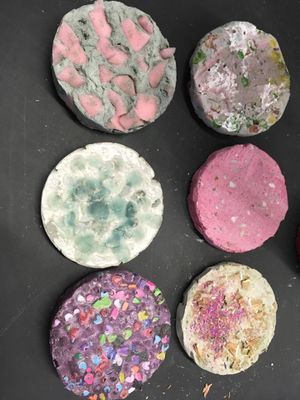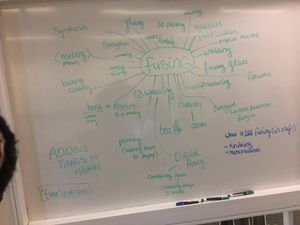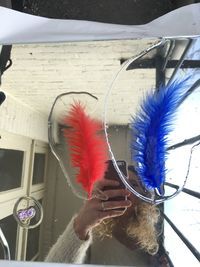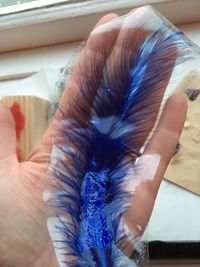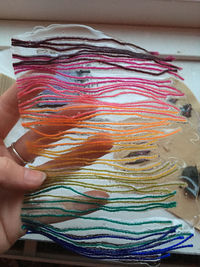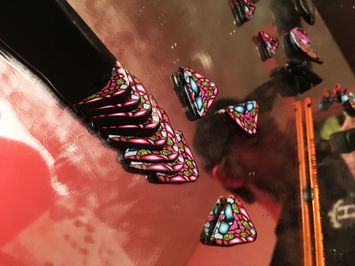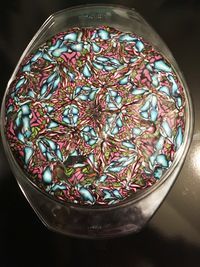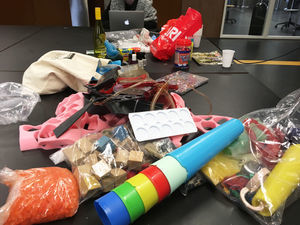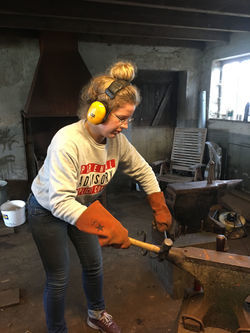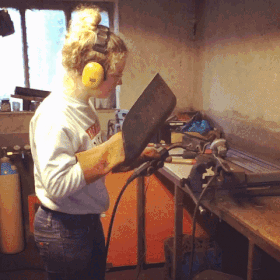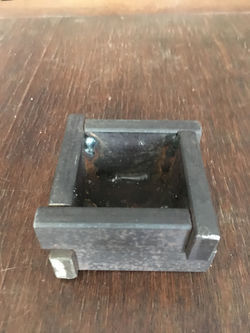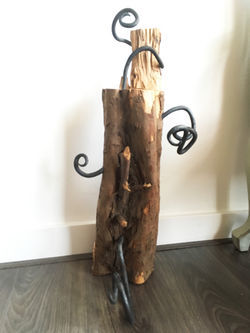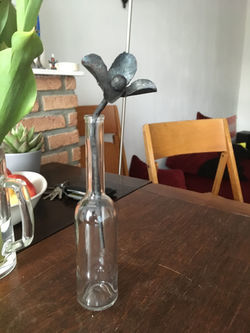Difference between revisions of "User:Isagaastra"
Isagaastra (talk | contribs) |
Isagaastra (talk | contribs) |
||
| Line 13: | Line 13: | ||
===18-2=== | ===18-2=== | ||
I’ve been doing research on historical ways of fusing. Welding is something i find interesting, because it’s something I've never been in touch with before. I would really like to make something with steel, something big and heavy because i love the way how this material automatically gives a work a rough and indestructible feeling. So I was searching for artists who work with this principle, and with whom I might be able to get in touch with. I remembered the big insect artwork of steel in my parents garden and got in touch with the artist which they bought it from. Johan Lossie was very kind and really wanted to help me. I explained my assignment and we talked a bit about the different possibilities and he talked to me about “klinken”, the technique where the Eiffel Tower is made of. We decided to go in that direction and made an appointment for an entire Saturday to work on a piece. His workplace is on a big farm and I got a big list of things I need to bring so I am very curious. | I’ve been doing research on historical ways of fusing. Welding is something i find interesting, because it’s something I've never been in touch with before. I would really like to make something with steel, something big and heavy because i love the way how this material automatically gives a work a rough and indestructible feeling. So I was searching for artists who work with this principle, and with whom I might be able to get in touch with. I remembered the big insect artwork of steel in my parents garden and got in touch with the artist which they bought it from. Johan Lossie was very kind and really wanted to help me. I explained my assignment and we talked a bit about the different possibilities and he talked to me about “klinken”, the technique where the Eiffel Tower is made of. We decided to go in that direction and made an appointment for an entire Saturday to work on a piece. His workplace is on a big farm and I got a big list of things I need to bring so I am very curious. | ||
| + | |||
| + | [https://en.wikipedia.org/wiki/Welding Wikipedia page about Welding] | ||
| + | [https://nl.wikipedia.org/wiki/Klinken_(verbinding) Wikipedia page about 'Klinken"] | ||
===21-2=== | ===21-2=== | ||
| Line 19: | Line 22: | ||
===22-2=== | ===22-2=== | ||
I tried to motivate myself to just stop thinking too much and just start somewhere. So i started off experimenting with the materials we had laying around in our home and tried to fuse them in one way or another. I worked with Glue, feathers, candles, threads and beads. I wanted to see if i could change the softness of the feather without changing its looks. That worked out pretty well. I also got the idea of fusing colors with clay. I bought five colors of FIMO clay and started rolling small snakes of different colours. I created an intricate design and rolled it out smaller and smaller. I moulded it around a glass bowl and baked it in the over. It turned out really nice in my opinion. This would be something I would like to experiment with further. | I tried to motivate myself to just stop thinking too much and just start somewhere. So i started off experimenting with the materials we had laying around in our home and tried to fuse them in one way or another. I worked with Glue, feathers, candles, threads and beads. I wanted to see if i could change the softness of the feather without changing its looks. That worked out pretty well. I also got the idea of fusing colors with clay. I bought five colors of FIMO clay and started rolling small snakes of different colours. I created an intricate design and rolled it out smaller and smaller. I moulded it around a glass bowl and baked it in the over. It turned out really nice in my opinion. This would be something I would like to experiment with further. | ||
| + | |||
| + | [https://www.youtube.com/watch?v=yfrkFT706Qc example of clay caning] | ||
[[File:Veren_in_lijm1.jpg|200px|feathers in glue]] [[File:Veren_in_lijm6.jpg|200px|Dried glue on feather]] [[File:Garen_in_lijm2.jpg|200px|threads dried in glue]] [[File:Fimoclay2.jpg|355px|clay caning technique, "fusing the colors"]] [[File:Fimoclay5.jpg|200px|Cutting the cane and combine the slices]] [[File:Fimoclay8.jpg|200px|Glass bowl covered in clay]] | [[File:Veren_in_lijm1.jpg|200px|feathers in glue]] [[File:Veren_in_lijm6.jpg|200px|Dried glue on feather]] [[File:Garen_in_lijm2.jpg|200px|threads dried in glue]] [[File:Fimoclay2.jpg|355px|clay caning technique, "fusing the colors"]] [[File:Fimoclay5.jpg|200px|Cutting the cane and combine the slices]] [[File:Fimoclay8.jpg|200px|Glass bowl covered in clay]] | ||
| Line 30: | Line 35: | ||
Today I had the workshop with the steel artist. We met up at his house at 10 and then drove to his workplace at a cow farm. It was nothing more then an old dirty barn, but that made me feel tough at forehand. He started telling me about his work and how he found his passion in working with steel. He told me it would be good to start with just forging and welding a bit to get the feeling, before I made a really thought through piece. It was a lot harder then I thought it would be; I still had to use a lot of strength to forge the material in the way I wanted to. Eventhough I'm not really used to work in 3d, I really enjoyed it. When I started to get the hang of it I started thinking about an art piece. I found a really beautiful piece of woord outside the barn, the farmer had cut the trees for firewood and left some of the pieces. I immediately liked the idea of fusing wood and steel together in some kind of way. So we started working on that idea. There were some small branches coming out of the wood and I wanted to try to make the steel look like it did too. I had to forge the steel in a natural flow of curls, to make it look realistic and light. Once I made the steel branches we hammered them as far in the wood as we could, making it impossible to ever take them out again. I really like how the piece turned out. In the end I realized i actually made two different examples of fusing: I fused steel and wood together, but I also made a box entirely out of steel by welding different pieces together. It was a very long and intensive but very productive day. I really learned a lot, and I got really positive feedback from the artist. | Today I had the workshop with the steel artist. We met up at his house at 10 and then drove to his workplace at a cow farm. It was nothing more then an old dirty barn, but that made me feel tough at forehand. He started telling me about his work and how he found his passion in working with steel. He told me it would be good to start with just forging and welding a bit to get the feeling, before I made a really thought through piece. It was a lot harder then I thought it would be; I still had to use a lot of strength to forge the material in the way I wanted to. Eventhough I'm not really used to work in 3d, I really enjoyed it. When I started to get the hang of it I started thinking about an art piece. I found a really beautiful piece of woord outside the barn, the farmer had cut the trees for firewood and left some of the pieces. I immediately liked the idea of fusing wood and steel together in some kind of way. So we started working on that idea. There were some small branches coming out of the wood and I wanted to try to make the steel look like it did too. I had to forge the steel in a natural flow of curls, to make it look realistic and light. Once I made the steel branches we hammered them as far in the wood as we could, making it impossible to ever take them out again. I really like how the piece turned out. In the end I realized i actually made two different examples of fusing: I fused steel and wood together, but I also made a box entirely out of steel by welding different pieces together. It was a very long and intensive but very productive day. I really learned a lot, and I got really positive feedback from the artist. | ||
| − | [[File:Smith2.jpg| | + | [[File:Smith2.jpg|250px|forging steel]] [[File:Smith_me.gif|335px|Me welding for the first time]] [[File:Smith_box.jpg|250px|Welded box out of steel]] [[File:Smith_wood.jpg|250px|Final art piece I made]] [[File:Smith_flower.jpg|250px|some of the experiments I did with forging and weldingl]] |
| + | |||
| + | |||
| + | |||
| + | ===9-3=== | ||
| + | This week we had a drawing bootcamp at Gorssel with the Illustration department so I could not make it to the class. I feel a bit out of the flow because we also had holiday the week before. I cannot really think of other fusing experiments I really want to do. I do have a lot of thoughts on the Manifesto. At illustration we also get the question, 'Why do you make?' a lot. The borders of the Illustration field are pushed further then ever, so it's very important to know what you're doing, and more important to know why you're doing it. If you know where your intrinsic motivation on making comes from, you can explore and develop that in a more professional direction. I always say that my main reason of making, is to make people happy. It might be simple, cliché or naive, but that's really how I feel about it. (to be continued) | ||
| + | ===16-3=== | ||
| + | Today we met up again with the fusing group. We collected the cement tiles we made before the holiday to experiment some more with them. They had dried up completely, but some of them were very fragile. I think that was because we combined the cement with different fluids like paint and chocolate ice-cream which changed the structure. Also we didn't really measure the ratio water and cement which made it more fragile then it was supposed to be. We managed to get almost all of the tiles out of our moulds, just two of them broke. Then we went to the ceramic station to polish the tiles. The different materials we used reacted very different to the polishing proces. The foam for example, got really dirty and polluted by the cement, while the tiles combined with glass were really dirty before polishing, and became beautifully see-through after. The effect was really different then I first expected, I thought it would be quite easy to polish them really smooth but that was not possible because they were really thin. | ||
| + | [[File:tiles 1.jpg|300px|the moulds after drying]] [[File:tiles 2.jpg|300px|getting the cement out of the moulds]] [[File:tiles 3.jpg|300px|polishing the tiles]] [[File:tiles 4.jpg|300px|result of the polishes tiles]] | ||
==Manifesto== | ==Manifesto== | ||
Revision as of 12:21, 16 March 2017
Isa Gaastra - Isagaastra96@gmail.com
Contents
Logboek
7-2
We had a very nice first meeting with the (con)fusing group. We got very very deep into the subject, to the point of where the entire universe was actually created by fusing. Fusing is Life. But we had to focus on one point, so we decided to first define Craft. When we did this, the better we could find out wat fusing could be. We decided to all give an historical example of Fusing in craft that we find interesting ourselves.
17-2
I have been reading several books about the subject craft, and i get inspired and confused at the same time. I think im too much contemplating about what Fusing means to me that it keeps me from making stuff.
18-2
I’ve been doing research on historical ways of fusing. Welding is something i find interesting, because it’s something I've never been in touch with before. I would really like to make something with steel, something big and heavy because i love the way how this material automatically gives a work a rough and indestructible feeling. So I was searching for artists who work with this principle, and with whom I might be able to get in touch with. I remembered the big insect artwork of steel in my parents garden and got in touch with the artist which they bought it from. Johan Lossie was very kind and really wanted to help me. I explained my assignment and we talked a bit about the different possibilities and he talked to me about “klinken”, the technique where the Eiffel Tower is made of. We decided to go in that direction and made an appointment for an entire Saturday to work on a piece. His workplace is on a big farm and I got a big list of things I need to bring so I am very curious.
Wikipedia page about Welding Wikipedia page about 'Klinken"
21-2
We had a group meeting today to think about our shared example. We, again, had new insights and visions on fusing. We thought about creating different kinds of paper and combining those into one book or poster, but we thought that would be a bit too simple. We also came up with the idea of all creating a square in the way we look at fusing, and then combining them in a cube. Same as with the paper: a bit too simple. We thought it would be better if we would think of something where we really have to work together, something we could not make on our own. So we came up with the idea of creating tiles. Putting different kinds of materials with different qualities in a mould, let it harden and later cut them into slices and create tilles which we can put on a wall. We thought it was important to recycle the materials so we went to the shop “Scrap” and bought all kinds of glass, plastics, fabrics and other materials.
22-2
I tried to motivate myself to just stop thinking too much and just start somewhere. So i started off experimenting with the materials we had laying around in our home and tried to fuse them in one way or another. I worked with Glue, feathers, candles, threads and beads. I wanted to see if i could change the softness of the feather without changing its looks. That worked out pretty well. I also got the idea of fusing colors with clay. I bought five colors of FIMO clay and started rolling small snakes of different colours. I created an intricate design and rolled it out smaller and smaller. I moulded it around a glass bowl and baked it in the over. It turned out really nice in my opinion. This would be something I would like to experiment with further.
23-2
today we started the shared example with our group. Max and I made round plastic moulds for the tiles. We made cement with powder and water and mixed it with different materials like foam, paint, glass, plastic, cinnamon powder, nail polish, etc. We made 20 different tiles and planned to make at least another round of 20 after the break. When they're dried we’re going to polish and glaze them and create a wall or floor with our own created tiles.
4-3
Today I had the workshop with the steel artist. We met up at his house at 10 and then drove to his workplace at a cow farm. It was nothing more then an old dirty barn, but that made me feel tough at forehand. He started telling me about his work and how he found his passion in working with steel. He told me it would be good to start with just forging and welding a bit to get the feeling, before I made a really thought through piece. It was a lot harder then I thought it would be; I still had to use a lot of strength to forge the material in the way I wanted to. Eventhough I'm not really used to work in 3d, I really enjoyed it. When I started to get the hang of it I started thinking about an art piece. I found a really beautiful piece of woord outside the barn, the farmer had cut the trees for firewood and left some of the pieces. I immediately liked the idea of fusing wood and steel together in some kind of way. So we started working on that idea. There were some small branches coming out of the wood and I wanted to try to make the steel look like it did too. I had to forge the steel in a natural flow of curls, to make it look realistic and light. Once I made the steel branches we hammered them as far in the wood as we could, making it impossible to ever take them out again. I really like how the piece turned out. In the end I realized i actually made two different examples of fusing: I fused steel and wood together, but I also made a box entirely out of steel by welding different pieces together. It was a very long and intensive but very productive day. I really learned a lot, and I got really positive feedback from the artist.
9-3
This week we had a drawing bootcamp at Gorssel with the Illustration department so I could not make it to the class. I feel a bit out of the flow because we also had holiday the week before. I cannot really think of other fusing experiments I really want to do. I do have a lot of thoughts on the Manifesto. At illustration we also get the question, 'Why do you make?' a lot. The borders of the Illustration field are pushed further then ever, so it's very important to know what you're doing, and more important to know why you're doing it. If you know where your intrinsic motivation on making comes from, you can explore and develop that in a more professional direction. I always say that my main reason of making, is to make people happy. It might be simple, cliché or naive, but that's really how I feel about it. (to be continued)
16-3
Today we met up again with the fusing group. We collected the cement tiles we made before the holiday to experiment some more with them. They had dried up completely, but some of them were very fragile. I think that was because we combined the cement with different fluids like paint and chocolate ice-cream which changed the structure. Also we didn't really measure the ratio water and cement which made it more fragile then it was supposed to be. We managed to get almost all of the tiles out of our moulds, just two of them broke. Then we went to the ceramic station to polish the tiles. The different materials we used reacted very different to the polishing proces. The foam for example, got really dirty and polluted by the cement, while the tiles combined with glass were really dirty before polishing, and became beautifully see-through after. The effect was really different then I first expected, I thought it would be quite easy to polish them really smooth but that was not possible because they were really thin.
